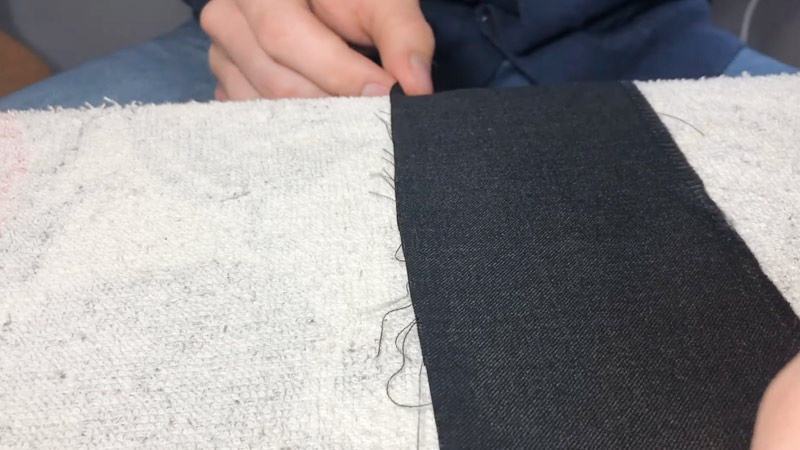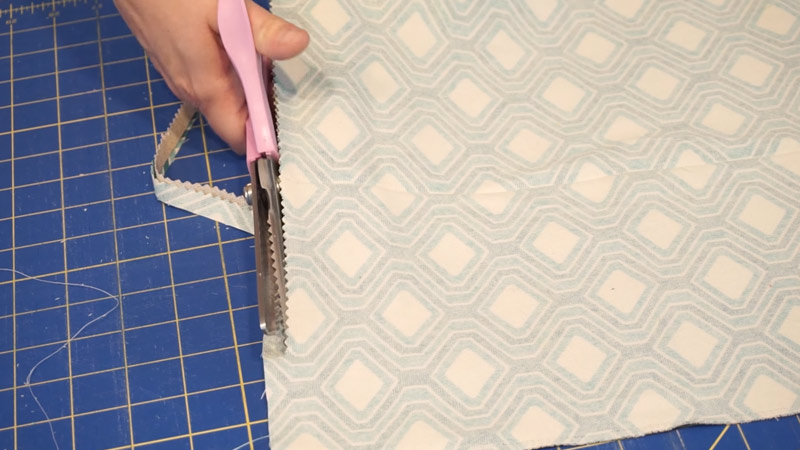Whether you’re working on a sewing project, making DIY crafts, or simply need to cut a piece of polyester fabric, fraying can be a concern. Polyester is a man-made fabric composed of long polymer chains derived from petroleum-based substances.
Fraying occurs when the threads of the fabric unravel at the cut edges, leading to a messy and unsightly finish. In this guide, we will explore the nature of polyester fabric, the factors contributing to fraying, and various techniques to cut polyester without it fraying.

Can You Cut Polyester Without It Fraying?
Polyester fabric can fray when you cut it. Cutting polyester fabric without it fraying is a common concern for crafters, sewists, and DIY enthusiasts.
Polyester, being a popular synthetic fabric known for its durability and affordability, can unravel at the cut edges if not handled correctly.
Fraying can not only mar the finished look of projects but also make sewing and crafting tasks challenging.
However, with the right techniques and tools, it is entirely possible to cut polyester without experiencing fraying issues.
Why Polyester Frays When You Cut It?
It’s crucial to understand the factors that contribute to fraying in polyester fabric:
Fabric Quality
The quality of the polyester fabric itself plays a significant role in its fraying tendencies. High-quality polyester tends to fray less than cheaper, lower-grade alternatives.
Investing in good fabric, coupled with the right cutting tools and techniques, ensures clean and professional results in sewing and crafting projects.
Thread Count
The thread count refers to the number of threads per square inch of fabric. Fabrics with higher thread counts generally have tighter weaves, reducing the likelihood of fraying.
Cutting Tools

Selecting the right cutting tools is vital when aiming to cut polyester fabric without fraying. High-quality fabric scissors or a sharp rotary cutter are essential for clean cuts, as dull blades can disturb the fabric’s weave and promote fraying. Pinking shears with serrated edges can also help prevent unraveling.
For finishing edges, a serger or sewing machine with a zigzag stitch setting can be employed. Moreover, using clear nail polish or fabric adhesive tapes to seal the cut edges can offer additional protection against fraying, ensuring a polished and professional outcome in your projects.
Cutting Technique
The way you cut the fabric also matters. Cutting with a rough or jagged motion can cause more fraying compared to smooth and precise cuts.
Fabric Manipulation
Avoiding fabric manipulation is crucial in preventing fraying when cutting polyester fabric. Pulling or stretching the fabric while cutting can disturb its weave, leading to unraveled edges.
To ensure clean and fray-free cuts, maintain a steady and smooth cutting motion without applying excessive force. Minimizing fabric manipulation allows the polyester fabric to retain its integrity, resulting in neat and professional finishes in sewing and crafting projects.
Fabric Finish
Some polyester fabrics come with a finishing treatment that helps reduce fraying. However, this finish may wear off over time or with washing.
Tips and Techniques to Stop Fraying Polyester
Avoiding fraying when cutting polyester fabric is essential to achieve clean and professional-looking results in your sewing and crafting projects.
Let’s explore various techniques and tips to cut polyester without it fraying:
Use Sharp Scissors or Rotary Cutter
Begin with high-quality fabric scissors or a sharp rotary cutter. Dull blades can crush the fabric and disturb the weave, leading to fraying. Keep your cutting tools dedicated solely to fabric to maintain their sharpness.
Consider Pinking Shears
Pinking shears have serrated blades that create zigzag edges when cutting fabric. This serrated edge helps prevent fraying by reducing the length of the exposed fabric threads. Pinking shears work well for lightweight and medium-weight polyester fabrics.
Serging or Overlocking
If you have access to a serger or overlocker sewing machine, you can finish the raw edges of the polyester fabric to prevent fraying. Sergers create a secure stitch while trimming the excess fabric, enclosing the edges and minimizing fraying.
Zigzag Stitch or Fray Check
If you don’t have a serger, you can use a regular sewing machine with a zigzag stitch setting to finish the raw edges. This method creates a similar effect to serging and helps prevent fraying. Alternatively, you can apply a product called “Fray Check” or fabric glue along the cut edges to seal and strengthen them.
Tape or Masking
Applying masking tape or clear packing tape along the edges before cutting can help stabilize the fabric and prevent fraying. The tape acts as a temporary barrier, reducing the risk of the fabric threads unraveling.
Freezer Method
For delicate or stretchy polyester fabrics, the freezer method can be useful. Place the fabric in a plastic bag and freeze it for several hours. The cold temperature temporarily stiffens the fibers, making the fabric less prone to fraying during cutting.
Heat-Sealing
For synthetic fabrics like polyester, heat-sealing can be an effective method to prevent fraying. Using a heat source like a candle flame or a soldering iron, carefully run the flame or tip along the cut edge to melt and seal the fabric fibers. Take extreme caution with this method to avoid accidental burns or damage to the fabric.
Cutting Techniques
When cutting polyester fabric, avoid dragging the scissors or cutter along the fabric. Instead, use a smooth, continuous motion to make clean cuts. Minimize stretching or pulling the fabric while cutting to maintain the weave’s integrity.
Test and Sample
Before cutting your main fabric, test the cutting technique on a small sample piece to see how the fabric responds. This way, you can fine-tune your cutting technique and ensure the best results on your actual project.
Wash and Press
Before cutting the fabric, it’s a good idea to wash and press it to eliminate any sizing or finishes that might influence fraying. Washing can also help shrink the fabric if needed, making it easier to work with.
Use Fabric Shears with Serrated Blades
Some fabric shears come with serrated blades specifically designed to prevent fraying. These shears grip the fabric and reduce the chances of the threads unraveling.
Apply Clear Nail Polish
If you don’t have Fray Check or fabric glue, you can use clear nail polish to seal the cut edges. Apply a thin layer of clear nail polish along the edges and let it dry. This creates a barrier that prevents fraying.
Finish Seam Allowances
If you’re sewing a garment or project with seams, finish the seam allowances with a serger, zigzag stitch, or French seam. This encloses the raw edges within the seam, preventing fraying.
Use Fabric Adhesive Tape
Fabric adhesive tapes, such as hem tapes, can also be used to prevent fraying. Apply the tape along the cut edges before sewing or using other finishing techniques.
Avoid Using Scissors with Teeth
Scissors with teeth (sometimes called “shark fin” scissors) are designed for specific purposes and can cause more fraying when used on polyester fabric. Stick to regular fabric scissors or pinking shears for the best results.
FAQs
Yes, there are alternative methods to prevent fraying in polyester fabric without sewing or using special tools.
While heat-sealing can be effective for some synthetic fabrics, it is not recommended to use an iron for this purpose on polyester.
While regular adhesive tape may temporarily secure the edges, it is not a suitable long-term solution to prevent fraying.
Laser cutters can be used to cut polyester fabric, and they can offer clean and precise edges.
Pinking shears are more effective for lightweight and medium-weight polyester fabrics.
Conclusion
Polyester fabric, with its many benefits, is a popular choice for various sewing and crafting projects. While fraying can be a concern when cutting polyester, you can employ several techniques to prevent it.
From using sharp scissors and pinking shears to serging, zigzag stitching, and heat-sealing, each method has its advantages depending on the type of polyester fabric and your available tools.
With these tips and techniques, you can confidently cut polyester fabric without worrying about fraying, allowing you to create beautiful and professional-looking projects with ease.
Leave a Reply